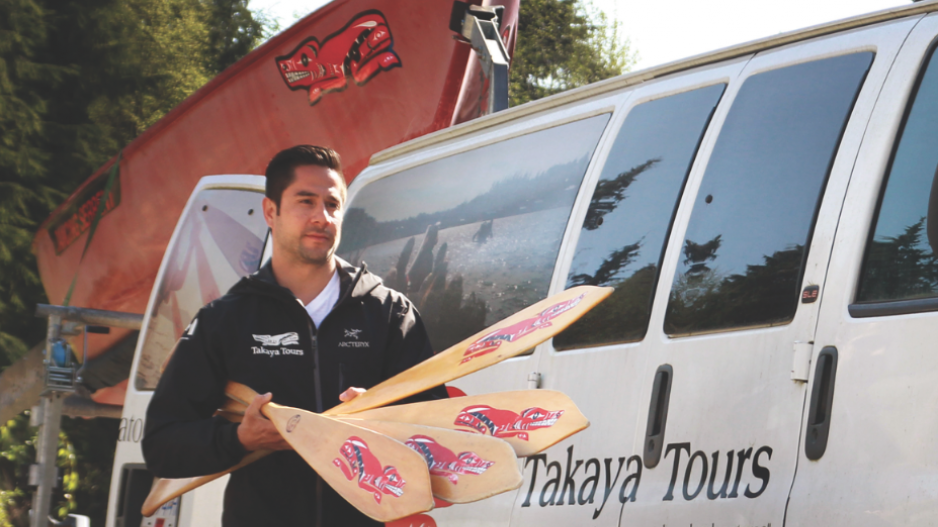British Columbia First Nations’ success at marketing tourism is drawing attention from counterparts globally who increasingly pay to have B.C. representatives visit their countries to share knowledge.
Aboriginal tourism marketers from around the world are also increasingly attending aboriginal tourism conferences held in Canada, to better understand how B.C. First Nations have rapidly expanded their participation in the industry.
Back in 2001, 892 aboriginal tourism businesses employed the equivalent of about 13,000 full-time workers in Canada. That has mushroomed to 1,527 businesses with the equivalent of 26,029 full-time employees, according to Aboriginal Tourism Association of Canada (ATAC) statistics.
When indirect jobs are included, the sector employs 39,156 people who make a combined $1.29 billion in wages and pay a combined $141.7 million in taxes.
As both chair of ATAC and CEO of the Aboriginal Tourism Association of BC (ATBC), Keith Henry is one of the most sought-after advisers on how to successfully market aboriginal tourism.
The Mexican government paid his way to a conference in the Baja peninsula last summer to speak to both indigenous and non-indigenous tourism operators about marketing, developing tourism products and training workers.
“Another invitation I had last year was to both Western Australia and Northern Territory in Australia,” Henry told Business in Vancouver. Western Australia Indigenous Tourism Operators Council and Tourism Australia paid his way to attend those events, he said.
At home, Henry has been active building a series of annual international tourism conferences.
“I started the first conference four years ago with no major funding to support it,” he said. “We had the support of the board of ATBC and wanted to raise the profile of our industry. We also wanted to try to start attracting other international indigenous
groups to form new alliances.”
After two international conferences in Osoyoos, the event moved to Whistler in 2014 and took place in Quebec City in March.
The conferences have grown increasingly cosmopolitan; in 2012 the event drew U.S. and Mexican representation, while this year in Quebec there are representatives from 10 countries: the U.S., Mexico, New Zealand, Australia, India, Chile, Nepal, Sweden, South Africa and Canada.
The World Indigenous Tourism Alliance and ATBC will host a separate event – the second Pacific Asia Indigenous Tourism Conference (PAITC) – September 12 to September 14. It comes three years after the inaugural PAITC, which was held in Darwin, Australia.
Henry’s ATBC is also partnering with the provincial destination marketing association Destination British Columbia to finance trips to events such as an international luxury tourism trade show in Shanghai, China, last November.
That conference helped travel agents from across China understand aboriginal tourism by showing them aboriginal dancing and culture.
“We can sell direct to Chinese visitors but it takes a lot of money to do that,” Henry said. “It’s better to work direct with a lot of travel agencies and tour operators where we educate them and their salespeople on what aboriginal tourism is.”
Henry said B.C. aboriginal tourism businesses are already starting to see increased interest from Chinese visitors.
One of those businesses that are rapidly increasing visitation is the Tsleil-Waututh-owned Takaya Tours.
Takaya project manager Dennis Thomas told BIV he estimated that the number of customers for Takaya’s cultural tours increased more than 50% to nearly 2,500 in 2014 from approximately 1,500 customers in 2013.
Those visits were either for walking tours or canoe rides up Indian Arm to see pictographs drawn on cliff walls by Thomas’ Tsleil-Waututh ancestors.
Thomas has been in his role for the past five years, and he credits some of the success his tour company has had of late to attending large mainstream tourism trade shows such as Rendez-vous Canada or the Canada’s West Marketplace trade show.
“Some of the big players in the tourism industry won’t take you seriously until they’ve known you for about five years,” he said. “Then, five years down the road, when they see you at these events, they know that you’re in the game. I’ve been approached by some of the big tour companies, such as Jonview [Canada] and Brewster [Travel Canada].” •




